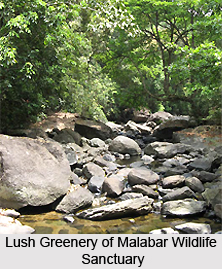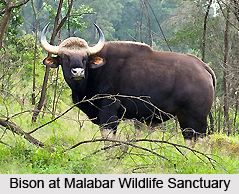 Malabar Wildlife Sanctuary is a biodiversity hotspot situated in Kakkayam town of Kozhikode district in the south Indian state Kerala. It spreads over the northwest slopes of the Western Ghats and the area comes under Nilgiri Biosphere Reserve. It also forms a part of Wayanad Elephant Reserve. It encompasses an area of about 75 square kilometres and shares its boundary with the forests of the Kalpetta Forest Range. In the west and north, the sanctuary is bordered by the plantations and forests of Peruvannamuzhy range and towards its south it is bordered with Tamarassery forest range.
Malabar Wildlife Sanctuary is a biodiversity hotspot situated in Kakkayam town of Kozhikode district in the south Indian state Kerala. It spreads over the northwest slopes of the Western Ghats and the area comes under Nilgiri Biosphere Reserve. It also forms a part of Wayanad Elephant Reserve. It encompasses an area of about 75 square kilometres and shares its boundary with the forests of the Kalpetta Forest Range. In the west and north, the sanctuary is bordered by the plantations and forests of Peruvannamuzhy range and towards its south it is bordered with Tamarassery forest range.
Geography of Malabar Wildlife Sanctuary
Rainfall in Malabar Wildlife Sanctuary owes to both northeast and southwest monsoons; however the southwest monsoon is heavier and starts in the first week of June. Temperature of the region ranges between 16 and 38 degree Celsius and the sanctuary enjoys a tropical climate. April and May have been recorded as the hottest months. The humidity at hilly regions varies from 60 to 100 percent whereas at the foothills and plains it ranges from 50 to 90 percent. At higher altitudes, mist can be witnessed frequently. A number of perennial and seasonal streams are there. The altitudinal variations and sharp topographic gradient encompassing perennial water sources, hillocks, marshy lands and deep valleys offer an ideal environment for supporting a great diversity of flora and fauna.
Flora of Malabar Wildlife Sanctuary
The floral diversity of Malabar Wildlife Sanctuary is commendable. The vegetation covers mostly include Marshy Grasslands, Southern Hill-top Evergreen forests, Grasslands, Southern Moist Mixed Deciduous, West-coast Semi evergreen and West-coast Tropical Evergreen forests. About 680 species of flowering plants have been recorded here out of which 226 are endemic to southern Western Ghats. Viable species of trees in the sanctuary include Humboldtia brunonis, Garcinia malabarica,
 Atuna indica, Syzygium floccosum, Syzygium stocksii, Eugenia argentea, Meteoromyrtus wynaadensis and others. Some of the species of plants grow only in Malabar Wildlife Sanctuary. Over 200 species of medicinal plants are found here along with about 50 ferns.
Atuna indica, Syzygium floccosum, Syzygium stocksii, Eugenia argentea, Meteoromyrtus wynaadensis and others. Some of the species of plants grow only in Malabar Wildlife Sanctuary. Over 200 species of medicinal plants are found here along with about 50 ferns.
Fauna of Malabar Wildlife Sanctuary
The rich faunal biodiversity of Malabar Wildlife Sanctuary include 41 species of mammals out of which 6 are Western Ghats endemics. Apart from these 179 species of birds are there with 5 globally threatened, 6 range restricted and 10 endemic species. Among the 36 varieties of reptiles dwelling in the sanctuary, 8 are Western Ghats endemics. Common fauna of the sanctuary include Nilgiri Langur, Leopards, Tigers, Gaurs, Elephants, Brown Palm Civet, Lion-Tailed Macaque, White-Bellied Blue Flycatcher, Small Sunbird, Malabar Parakeet, Grey-Headed Bulbul, Oriental Darter, Kerala Laughing Thrush and many more. The world`s largest venomous snake King Cobra is also an inhabitant. In addition to these 38 amphibian species have been found here. 143 species of butterflies inhabit the forests such as Prioneris sita, Papilio dravidarum, Papilio paris, Papilio liomedon and many others. About 52 species of fishes are supported by the streams.
Eco Tourism in Malabar Wildlife Sanctuary
The major tourist zone of Malabar Wildlife Sanctuary lies in the southern portion enclosing the reservoirs of this sanctuary. The crystal clear streams and the cascading Urakkuzhy Waterfall are enchanting. Other frequently visited places in the sanctuary include the animal rehabilitation centre, a garden, a dam and Indian Institute of Spices Research. The picturesque sanctuary with its rich biodiversity and beautiful landscape forms an inviting tourist destination.
Visiting Information
Malabar Wildlife Sanctuary is situated at a distance of about 65 kilometres from Calicut city from where bus services can be availed. Roadways also connect the sanctuary with other cities. The nearest railway station is at Calicut, 67 kilometres away whereas the nearest airport is Calicut Airport, at a distance of 87 kilometres.











